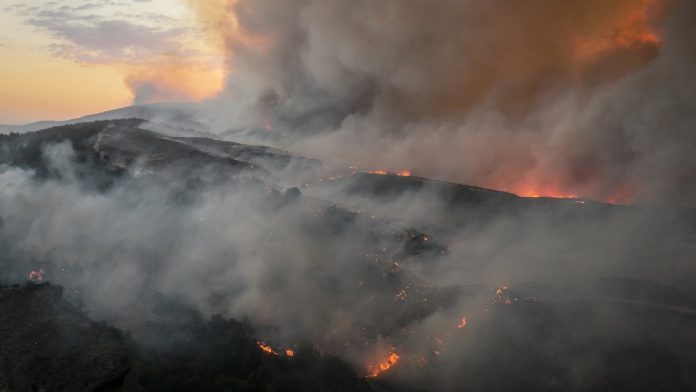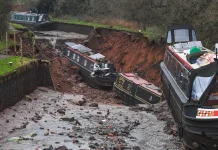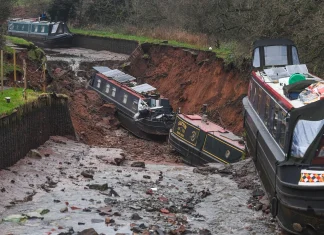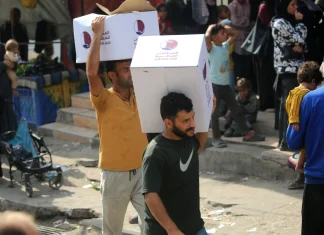Flames on the Historic Shores: Wildfire Ravages the Gallipoli Peninsula
As dusk fell over the ancient lands of the Gallipoli peninsula, an ominous glow lit the night sky—fiery tongues licking greedily at the hillsides, smoke billowing thick and black, swallowing the stars. This haunting scene unfolded over the night as a ferocious wildfire tore through the northwestern coast of Turkey, igniting fear and uncertainty in a region steeped in history and natural beauty.
More than 250 people were hurriedly evacuated from their homes, five villages uprooted as the blaze, fanned by fierce winds, surged dangerously close to the bustling waters of the Dardanelles Strait. This is no ordinary fire—it is a modern-day inferno challenging both nature and humanity on a storied landscape etched with the memory of thousands of soldiers who perished during World War I’s Gallipoli campaign.
The Fire’s Fury: From Canakkale to Gelibolu
The wildfire erupted late on a warm summer afternoon near Gelibolu, a small town that has witnessed centuries of passage—merchant ships, travelers, armies, all threading through the narrow strait where Europe kisses Asia. Within hours, the wind-driven flames swept through dry hills, lighting up the darkness like a wildfire cathedral, forcing residents to flee in a race against time.
“We relocated 251 residents from five villages as a precaution,” explained Omer Toraman, governor of the Canakkale province, via a message posted on X, the social media platform formerly known as Twitter. “Tonight, our priority is the safety of our people.”
Local footage shared across social networks captured the eerie spectacle of radiant fire-rims on the hillsides, the roar of crackling flames almost audible through the screen. Shadows danced wildly in the glow, and thick smoke clawed its way upwards to the heavens, spreading a hazy pall that settled over the historic peninsula.
Racing the Clock: A Herculean Response
Firefighters worked tirelessly through the darkness, refusing to yield to the night. By dawn, a formidable aerial fleet had taken to the skies—12 planes and 18 helicopters joined the nearly 900 ground personnel battling the blaze with every tool at their disposal. The Turkish Forestry Directorate’s relentless operation formed a human shield against destruction, dousing flames, clearing dry brush, and carving firebreaks.
“It’s a race against time,” one firefighter, Mehmet Sahin, shared as he took a brief breath during a rare pause. “These hills have been dry for months, and the wind doesn’t help. But we’ve trained for this. We won’t let this fire define our home.”
History Under Threat
The Gallipoli peninsula is no stranger to conflict or hardship. Its soil is hallowed, home to cemeteries and memorials honoring soldiers from different nations who fought and fell here a century ago. The war memorial authorities announced the closure of access to historical sites near Eceabat, keen to preserve these solemn places and keep visitors safe.
But the damage extends beyond history books. This area is beloved not only for its past but for its present—the scenic beauty, the serene landscapes, and the cultural richness that draws tourists year-round. People come from around the globe to stand in the shadow of Troy’s ruins or walk the beaches where soldiers once battled, seeking connection to stories that shaped the modern world.
“Every year, thousands of visitors come here to reflect, to learn, and to experience the spirit of Gallipoli,” said Leyla Demir, a local tour guide who grew up in the region. “The fires threaten our livelihood and our heritage. But more than that, they remind us how fragile this land has become.”
A Scorching Pattern: Wildfires and Climate Realities
The burning of Gallipoli is part of a grim pattern unfolding across Turkey and the wider Mediterranean region. This year alone, Turkish authorities have reported 192 wildfires, scorching over 110,000 hectares—an area larger than the entire city of Istanbul. Multiple fronts have erupted simultaneously, stretching firefighting resources thin and prompting repeated evacuations near the Dardanelles and elsewhere.
Just days ago, 2,000 people were displaced by another fire on the opposite side of the strait, with many hospitalized for smoke inhalation. Earlier, shipping lanes crucial for international trade through the Dardanelles were disrupted, underscoring how these natural disasters ripple far beyond local communities.
Experts overwhelmingly point to human-driven climate change as a catalyst fuelling such infernos. Prolonged droughts, heatwaves, and shifting weather patterns create tinderbox conditions primed for rapid spread. In Canakkale, Governor Toraman acknowledged the province has suffered “extremely severe drought” over the past year—a critical factor in the fire’s ferocity.
“These fires aren’t just nature’s fury—they’re a warning,” said climate scientist Dr. Aylin Kaya, based in Istanbul. “What we’re seeing is an accelerated pattern of disasters linked directly to rising global temperatures and environmental degradation. Turkey, like many countries, must urgently adapt and act.”
Reflecting on the Flames
As the smoke slowly lifts over Gallipoli, questions linger. How do communities rebuild when the land they cherish is repeatedly scorched? What does it mean for a place so deeply entwined with human history to face a new kind of battlefield—one with fire instead of bullets? And what lessons can the world draw from these shifting frontlines of climate crisis?
For the evacuated villagers, it is a matter of survival and resilience. For historians and travelers, a somber reminder of the interplay between human legacy and nature’s unpredictability. For all of us, it is an invitation to listen—really listen—to the land’s desperate call for care and change.
Next time you see a wildfire in the news, pause to think about the lives disrupted, the ecosystems altered, and the history poised on the brink. These flames are more than headlines. They are stories—urgent, raw, and human.
How will we choose to respond?










